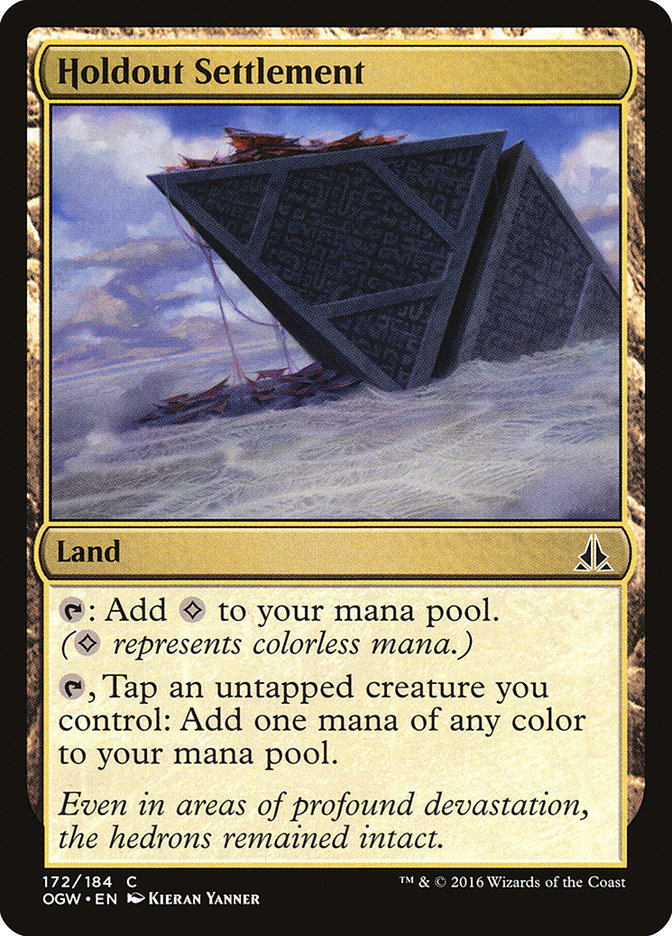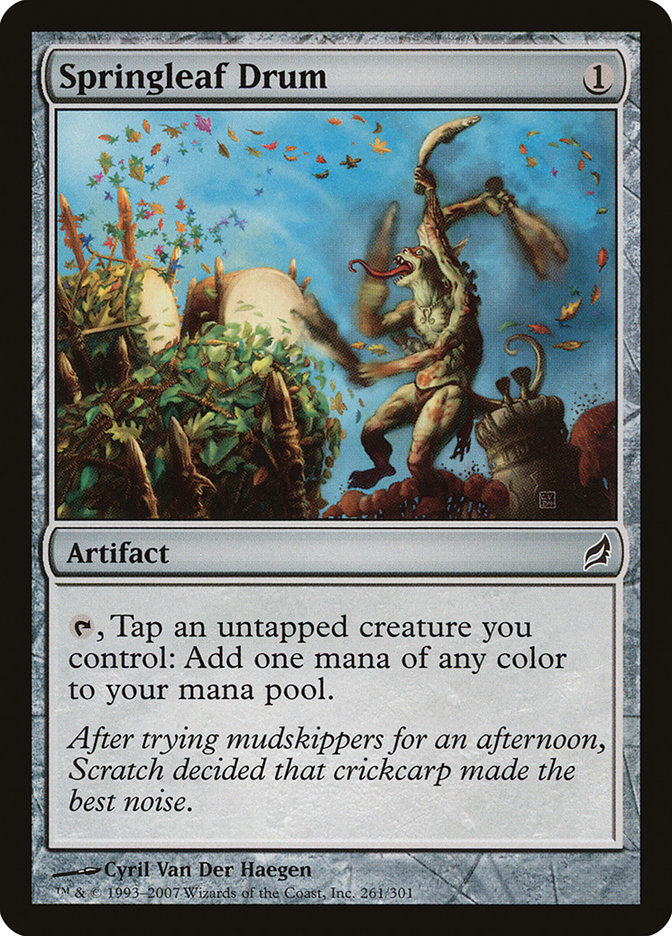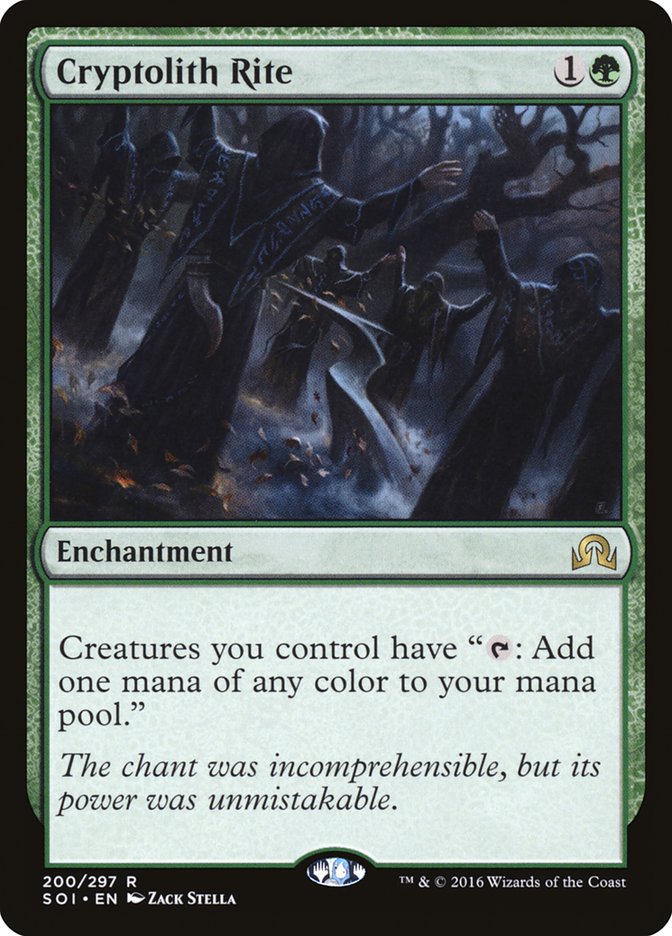Asentamiento contumaz Carta MTG
| Rareza | Común |
| Tipo | Tierra |
| Liberado | 2016-01-22 |
| Coleccione símbolo | |
| Coleccione nombre | Oath of the Gatewatch |
| Coleccione código | OGW |
| Número | 172 |
| Frame | 2015 |
| Disposición | Normal |
| Border | Negra |
| Ilustrado por | Kieran Yanner |
Texto de la carta
{T}: Agrega {C} a tu reserva de maná. ({C} representa maná incoloro.) {T}, girar una criatura enderezada que controlas: Agrega un maná de cualquier color a tu reserva de maná.
Incluso en zonas totalmente arrasadas, los edros seguían intactos.
Cartas Similares
El asentamiento aislado se destaca como una opción de tierra única en el arsenal de Magic: The Gathering. Su contraparte más comparable es el Campamento del Superviviente, que comparte la característica de enderezar una criatura sin enderezar que controlas para generar un mana de cualquier color. La similitud radica en su capacidad para diversificar los recursos de maná sin enderezarse a sí mismos, una propiedad que no se encuentra en muchas tierras.
Otra carta similar es el Tambor de Hojalata, que también requiere enderezar otra criatura para producir mana. Sin embargo, el Tambor de Hojalata es un artefacto y no cobra mana por su activación. Esta puede ser una diferencia sutil pero significativa en el juego, especialmente en las primeras etapas cuando el mana es escaso. Por otro lado, el asentamiento aislado no requiere ninguna inversión previa para empezar a usar su habilidad, ya que es una tierra.
Algunos también pueden trazar líneas paralelas entre el Asentamiento Aislado y el Rito de Cryptolith debido a su generación de mana basada en criaturas, aunque el Rito de Cryptolith otorga esta habilidad a todas las criaturas en lugar de necesitar enderezar una carta adicional. Esto hace que el Asentamiento Aislado sea una opción más situacional pero potencialmente favorable en mazos enfocados en la vigilancia o el mal de invocación.
Mazos que usan esta carta
Mazos MTG usando Asentamiento contumaz. Profundiza en la estrategia de los mazos, cartas de aparador, lista de ideas y exportación para jugar en ARENA o MOL.
| # | Nombre | Formato | Arquetipo | Evento |
|---|---|---|---|---|
 | Walls Combo | Pauper | Walls Combo | Pauper Challenge 32 2023-12-09 (1) |
 | Sliver Sliver Sliver | Pauper | Slivers | Tappa LP Comense Pauperissima "Road to Milano" @Magic Akiba |
 | Slivers | Pauper | Slivers | Lega Pauper Canavese - 4a Tappa Paupergeddon Winter Edition 2023 - 25 Players |
 | Naya Combo | Pauper | Boros Bully | BLUE - SAT - 1PM - Chicago Pauper Cup |
 | Walls Cascade | Pauper | Walls Cascade | Pauper League 2023-12-26 |
Beneficios de la carta
Ventaja de carta: El Asentamiento de Refugio asegura que nunca te quedes rezagado en la gestión eficiente de tus recursos. Te permite taponar consistentemente cualquier criatura que controles para generar maná, convirtiendo efectivamente tus criaturas en posibles fuentes de maná y manteniendo un estado de juego fluido.
Aceleración de recursos: Esta tierra de utilidad es excepcional para acelerar el desarrollo de tu maná sin necesidad de taponarse a sí misma, ofreciendo una ventaja estratégica al dejar otras tierras disponibles para futuras jugadas. Esto es especialmente crucial, ya que te permite utilizar criaturas incoloras o aquellas con enfermedad de invocación para contribuir inmediatamente a tu reserva de maná.
Velocidad instantánea: Aunque el Asentamiento de Refugio no opera a velocidad instantánea por sí solo, permite el uso de criaturas para taponar y generar maná a velocidad instantánea. Esta sutileza estratégica te brinda la flexibilidad para responder a las jugadas de tu oponente durante su turno taponando una criatura para obtener ese tan necesario maná y desatar una sorpresa o truco a velocidad instantánea, dándote en última instancia la ventaja en la partida.
Desventajas de la carta
Requerimiento de descarte: Una desventaja notable del Asentamiento de Refugio es que exige taponar una criatura que controlas y que esté desocupada para producir maná. Este requerimiento obliga efectivamente a comprometer una carta que podría ser mejor utilizada en combate o defensa, reduciendo tu flexibilidad táctica.
Costo específico de maná: Aunque el Asentamiento de Refugio puede añadir un maná de cualquier color a tu reserva, todavía requiere un maná incoloro inicial para jugarse. Este costo puede ser restrictivo para mazos con colores abundantes que dependen de curvas de maná precisas.
Costo de maná comparativamente alto: El costo de activación de la carta no implica maná, sino que depende de la presencia de una criatura, lo cual añade indirectamente al costo de la carta. En algunas situaciones donde la presencia en mesa es esencial, esto podría ser más costoso en comparación con otros recursos de maná que no tienen tal requerimiento. Además, en mazos donde las criaturas son escasas o valiosas, esto puede ser una desventaja significativa.
Razones para incluir en tu colección
Versatilidad: El Asentamiento de Refugio proporciona una excelente utilidad como carta de tierra que también puede taponar cualquier criatura que controles para obtener maná de cualquier color. Su funcionalidad dual sirve a una amplia variedad de mazos, ayudándote a fijar tu base de maná sin sacrificar el tempo.
Potencial de combo: Su habilidad de convertir criaturas no taponadas en maná inmediato puede desbloquear numerosas oportunidades de combo. Los jugadores pueden encontrarlo particularmente útil en mazos que invocan criaturas con enfermedad de invocación o en mazos que buscan maximizar efectos de taponar y destaponar.
Relevancia meta: En un meta donde el maná rápido y la corrección de colores son cruciales, el Asentamiento de Refugio destaca. Su presencia permite una mayor flexibilidad, asegurando que puedas lanzar tus hechizos en curva, incluso en un mazo con una base de maná exigente.
Cómo vencer
El Asentamiento de Refugio es una carta de tierra de utilidad que ofrece a los jugadores una forma única de taponar criaturas para obtener maná en MTG. A diferencia de otras tierras que simplemente proveen maná, esta carta requiere una criatura para taponar en conjunto con ella, desbloqueando un color de elección. Esto puede ser particularmente útil en mazos multicolores que buscan ajustar las curvas de maná y aumentar la disponibilidad de colores.
Para contrarrestar de manera efectiva al Asentamiento de Refugio, se debe considerar estrategias que se centren en limitar la presencia de criaturas del oponente. Los hechizos de remoción son un enfoque sólido, ya que disminuyen directamente la capacidad del oponente de aprovechar la habilidad del Asentamiento de Refugio. La destrucción o denegación de tierras también puede ser efectiva, aunque típicamente no será la respuesta principal, ya que las criaturas son la parte esencial de esta dinámica.
Además, agregar el taponado de criaturas a tu plan de juego, a través de cartas que obliguen a las criaturas a permanecer taponadas o a entrar en juego taponadas, podría obstaculizar la capacidad de tu oponente para utilizar el Asentamiento de Refugio al máximo, ya que una criatura taponada no puede ser utilizada nuevamente para activar la habilidad de esta carta. En resumen, mantener el control sobre el campo de batalla y dificultar las estrategias basadas en criaturas de tu oponente son clave para superar la versatilidad proporcionada por el Asentamiento de Refugio.
Donde comprar
Si estás buscando comprar una carta MTG Asentamiento contumaz de un coleccione específico como Oath of the Gatewatch, existen varias opciones confiables que debes considerar. Una de las fuentes principales es tu tienda de juegos local, donde a menudo puedes encontrar paquetes de refuerzo, cartas individuales y mazos preconstruidos de colecciones actuales y pasadas. A menudo ofrecen el beneficio adicional de una comunidad donde puedes intercambiar con otros jugadores.
Para un inventario más amplio, particularmente de colecciones más antiguos, mercados en línea como TCGPlayer, Card Kingdom y Card Market ofrecen amplias selecciones y te permiten buscar cartas de colecciones específicos. Las plataformas de comercio electrónico más grandes como eBay y Amazon también tienen listados de varios vendedores, lo que puede ser un buen lugar para buscar productos sellados y hallazgos raros.
Además, el sitio oficial de Magic suele tener un localizador de tiendas y listas de minoristas para encontrar Wizards of the Productos con licencia costera. Recuerde comprobar la autenticidad y el estado de las cartas al comprarlas, especialmente a vendedores individuales en mercados más grandes.
A continuación se muestra una lista de algunos sitios web de tiendas donde puede comprar las Asentamiento contumaz y otras cartas MTG:
 COMPRAR
COMPRAR BurnMana es un socio oficial de TCGPlayer
- eBay
- Card Kingdom
- Card Market
- Star City Games
- CoolStuffInc
- MTG Mint Card
- Hareruya
- Troll and Toad
- ABU Games
- Card Hoarder Magic Online
- MTGO Traders Magic Online
Ver productos MTG
Legalidades
Formatos de Magic the Gathering donde Asentamiento contumaz tiene restricciones
| Formato | Legalidad |
|---|---|
| Commander | Legal |
| Legacy | Legal |
| Paupercommander | Legal |
| Modern | Legal |
| Oathbreaker | Legal |
| Pauper | Legal |
| Vintage | Legal |
| Duel | Legal |
| Pioneer | Legal |
Reglas e información
La guía de referencia para las reglas de las cartas Asentamiento contumaz de Magic: The Gathering proporciona las reglas oficiales, las erratas emitidas, así como un registro de todas las modificaciones funcionales que se han producido.
| Fecha | Texto |
|---|---|
| 22/01/2016 | Para activar la última habilidad, puedes girar cualquier criatura que controles que no esté girada, incluida una que no hayas controlado continuamente desde el comienzo de tu turno más reciente. (Ten en cuenta que girar la criatura no utiliza -l símbolo de girar].) |


